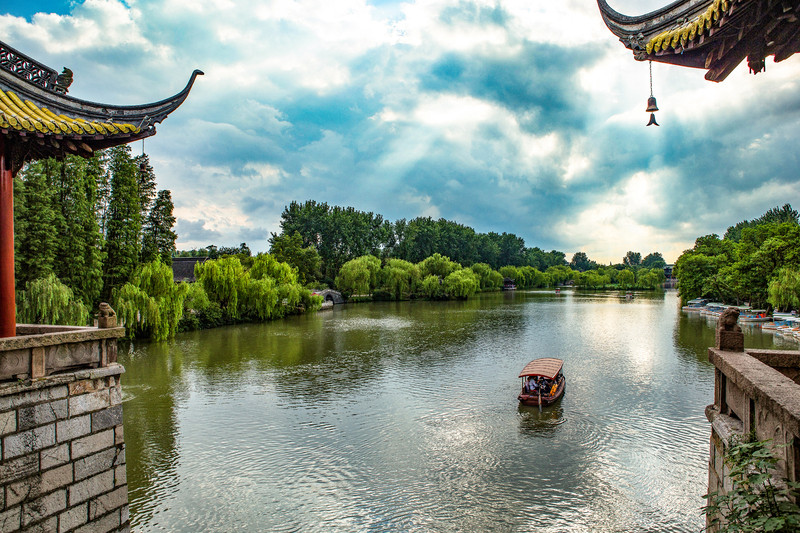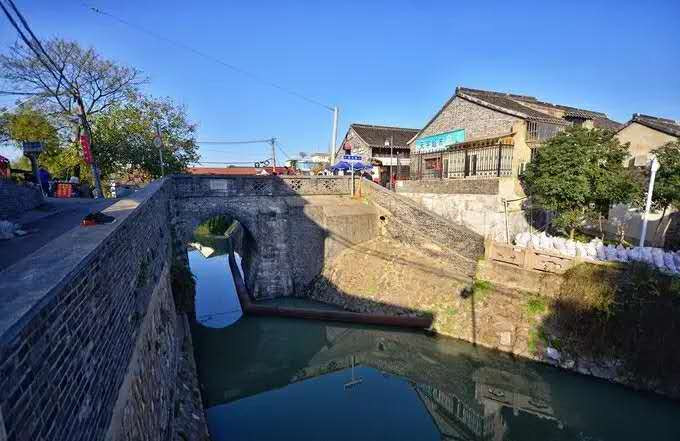Jiangsu has a low-key water town and an ancient city with lakes comparable to West Lake. It is known as the four major autumn colors in the south, but there are not many tourists
"My old friend left the Yellow Crane Tower in the west, and fireworks fell in Yangzhou in March." Every time I read this poem, I will be immersed in the brilliant spring light of Yangzhou. The plum blossoms are red, the willows are green, and the lone sail is far away, all of which give Yangzhou a lingering artistic conception. Having seen the brightness of March, Yangzhou is not inferior in October. The half-yellow and half-green leaves, bluestone streets and alleys and the cool autumn drizzle are the perfect match. As time flies, I can tell a small song from Yangzhou...

Yangzhou is located in the central Jiangsu region in the hinterland of the plains of the middle and lower reaches of the Yangtze River. Although it is located in the north of the Yangtze River, it is still located in the south of the Yangtze River. In addition to the different geographical scope in ancient times, Yangzhou also had a customs similar to Jiangnan."Erya" simply called "Jiangnan is Yangzhou". Its agile mountains and rivers have attracted countless literati's endorsement since ancient times. After autumn, Yangzhou traveled back to Guangling in seconds, which was so poetic that it was beautiful. Visiting Yangzhou in autumn is about this "meaning".

This time, we will slowly cruise along Yangzhou's lake scenery, gardens and ancient alleys, taste the ancient charm of the city in autumn, and slowly experience the poetic life of the ancients.
slender West Lake
"There are six out of thirty West Lakes in the world." Only the West Lake in Yangzhou is unique from other lakes for its delicate and graceful appearance, and it occupies the appropriate word "thin". The name of Slender West Lake was first found in Wu Qi's "Preface to Yangzhou Chuangzi" in the early Qing Dynasty. It probably means that it got this name because its waterway is curved and long and is located in the northwest of Yangzhou City.

In the first year of the Later Qianlong era, Qiantang poet Wang Hang came to Yangzhou because of his admiration. After enjoying the beautiful scenery here, he wrote a poem,"The weeping poplar continues to pick up the remnants, and the goose teeth and the red bridge are drawing pictures." It is also a pot of gold, so it should be called Slender West Lake." In the poet's eyes, Yangzhou, like Hangzhou, has prosperous scenery. He compared Hangzhou's West Lake with it and believed that the name of Slender West Lake is very vivid. Compared with Hangzhou West Lake, there is another kind of thin charm here.

When I first came to Yangzhou, it was an unwritten rule to visit the scenery of Slender West Lake, and the Diaoyutai at the foot of Xiaojin Mountain is an excellent place to enjoy the lake and autumn scenery. When the ginkgo trees in Xiaojinshan add a bit of autumn charm, and the stunning red flowers add a touch of charm. Come to the lake for a walk, all the poetic feelings will slowly unfold.

The Diaoyutai is actually a pavilion located at the end of the long embankment in the center of the lake. Previously, literati and elegant scholars played flute and piano here, but later Emperor Qianlong fished here, so it is also called "Diaoyutai". The third is facing the water. Through the garden cave, Wuting Bridge, Fuzhuang, Xiaojinshan, Baita, etc. are framed into the painting. It is extremely clever. Accompanied by the colorful trees by the lake and contrasting with the classical buildings, it has a unique style.
At this time, there was another gust of autumn wind blowing across the face, the lake rippled, and the scenery seemed to slowly "move" with it. Who said that this was not a "lake light and autumn color picture"?

Wuting Bridge, which is like a pair of good sisters to Diaoyutai, also has rare wonders. The most interesting thing is that you can watch the 16 moons. 1 in the sky and 15 in the water. When rowing to the foot of Wuting Bridge, you can see a full moon in all 15 bridge holes, overflowing with its charm.

It is said that "the world is three-point bright moon night, and two-point scoundrels are Yangzhou." In Yangzhou, the Moon City, there is naturally more than Wuting Bridge to admire the moon. Climbing on the Xichun Terrace beside the Slender West Lake, the moon is the "Spring Terrace Bright Moon", one of the 24 scenic spots in Yangzhou in the past. The Slender West Lake under the moonlight is even more graceful and charming, as Yu Dafu commented back then: "The bright moon of the Twenty-Four Bridge is one of the four autumn colors in southern China."

geyuan
I remember that it is recorded in the "Yangzhou Painted Boat Record" that "Hangzhou wins with lakes and mountains, Suzhou wins with cities and four, and Yangzhou wins with gardens and pavilions." It can be seen that Yangzhou's gardens were the best in the world during the Jiaqing period of Qianlong. Although with the repeated wars in the late Qing Dynasty, most of the forest gardens were destroyed and their names changed to Suzhou, the few gardens that have been preserved are also rare masterpieces.

The wonder of Yangzhou gardens is that they not only have the grandeur of the royal gardens in the north, but also have the artistic conception of Jiangnan gardens. As an intermediary of the northern and southern gardens, they occupy a place among Chinese classical gardens with their unique style. Geyuan, located in the northern corner of the ancient city, is one of the best, standing out with its taste of bamboo and stone. With the arrival of autumn, the branches and green bamboos are shrouded in the autumn fog, welcoming tourists exploring the secrets with a unique vitality.

Follow the lively Dongguan Street and enter the Geyuan Garden. When you step into it, the first thing you feel is the green and moist atmosphere of the garden. One scene in five steps and one painting in ten steps. Passing over the rockery, you can see the plaque of "Hutian from Spring" on Baoshan Tower. This seven-jacketed long building spans between the two mountains in summer and autumn, like a flyover flying in the sky. Walking in the corridor, you accidentally cross two seasons, the autumn mountains are red with maple and frost, and the summer mountains are green and beautiful.


Enjoy the scenery by leaning on the railing in Baoshan Tower. There is a shallow pond downstairs. Koi carp play in the water, sycamore trees on the bank of the pond cover the sun, and plantains stand tall. Looking at the autumn mountains from a distance, it looks like mountains with mountains outside the mountains. On the south wall of the corridor downstairs, there are carved stones in "The Story of Bamboo and Stone" written by Liu Fenghao from the Qing Dynasty, which are reserved for those who want to know the ins and outs of the garden.

If bamboo is picturesque, then stone is like poetry. The garden is not big, and the carefully built rockery retains the colors of spring, summer, autumn and winter with unique techniques. Stroll in this private garden and see the reflection of evergreen plants and stacked rocks, as if they are not bound by the rotation of nature. The pavilions built on the rocks blend with the jagged yellowstone. They are plated with a layer of golden light in the evening, and the poetic atmosphere is in full swing. This is quietly in my heart.
The red maples hidden in the bamboo trails in the secluded forest, the intertwined leaves, and the cloud shadows lingering on the lake all tell you that autumn is here in Yangzhou. Pick up a leaf of autumn maple and drop ink, immerse yourself in the gentle and boundless time in the garden, and truly experience the smooth life.

guxiang
Yangzhou was once known as the "Lane City" because of its ancient streets, deep alleys, and long and narrow. The winding and deep alleys wrap around every detail of this ancient city. The simple atmosphere pervades from each green brick and stone. The city customs of old Yangzhou are hidden in the ancient streets and alleys. In the early morning or evening, you can walk through it without deliberately looking for it to discover the most realistic picture of life in Yangzhou's old city.

Caiyi Street, which is characterized by buildings during the Ming and Qing Dynasties, is one of the streets with relatively intact traditional features in the old city of Yangzhou. Walking out of Dongguan Street and walking all the way to Caiyi Street, there are small bridges and flowing water along the way, and we encounter a narrow alley called "Tianningmen Street", which was once the imperial road traveled by Qianlong. Walking along Caiyi Street, there are many time-honored shops and historical buildings on both sides, such as Luopin's former residence, Jingde Guild Hall, Yang's residence, etc.

There is Dadongmen Bridge on Caiyi Street. Shen Fu and his beloved wife Yun Niang once stayed temporarily by the bridge. I am sure that they will remember this happy time when they later wrote "Six Chapters of a Floating Life" in paper and writing. Cross under the bridge and enter the South Lecture Dun, one of the three streets and eight alleys. The path is particularly peaceful. I want to imagine that Dongguan Street, which is full of tourists, is only 100 meters away.

The old houses are neatly arranged. The old people are sitting leisurely in front of their homes basking in the sun while peeling the cock-head rice and water chestnut from the autumn harvest. Residents nearby are leisurely picking up well water. Along the way, the shadows of the trees danced and the flowers bloomed just right.

Renfengli, which is called "Fishbone Lane" by Yangzhou residents in Laocheng District, is a different scene. It is a small ancient bridge, mottled walls, and willow trees. It is very literary and artistic. It runs north-south, like the backbone of a fish, and the head alley, second alley, and third alley are neatly arranged in the east-west direction... Like fish bones. On these fish bones are scattered several elegant folk houses, waiting for tourists to explore one by one.


Of course, Yangzhou's ancient streets and alleys are far more than these, such as Desheng Bridge, which is lined with knife and scissors shops, Guangling Road, which connects the history of Yangzhou, and Dingjiawan, which was once a gathering place for salt merchants, are worth visiting.
some pictures come from the internet
Previous Article:Travel Notes on Slender West Lake in Yangzhou, Jiangsu
Next Article:Where to go to play in Jiangsu? Wanwei Yangzhou City
